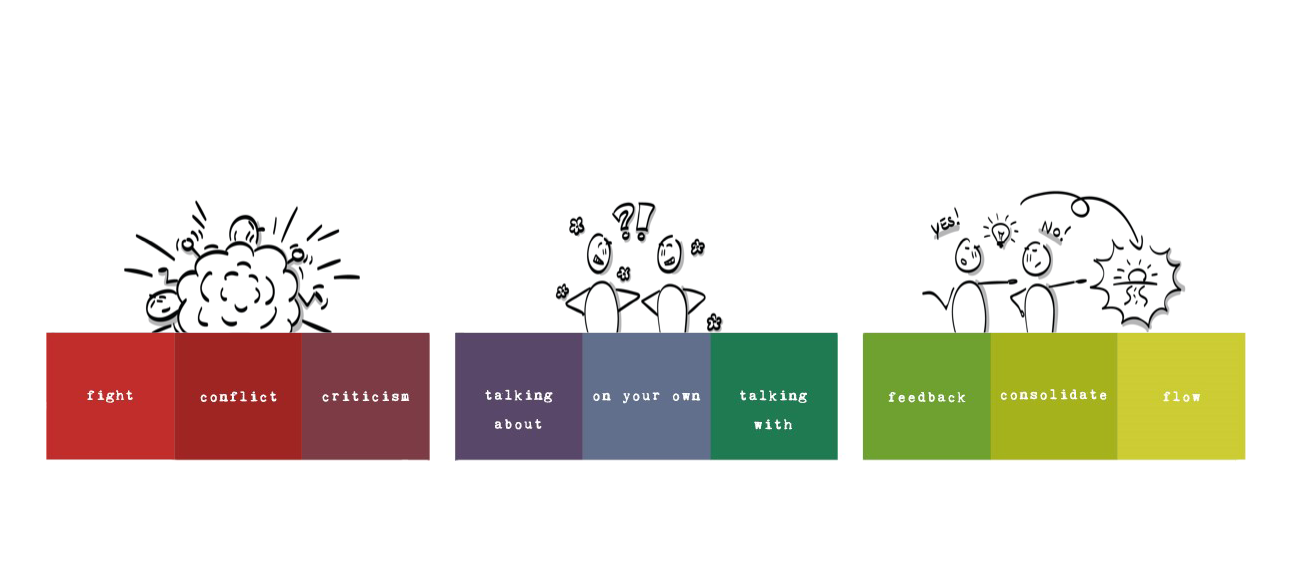When people work together, there are bound to be conflicts now and then. This doesn’t have to be bad thing – no pain, no gain. If we think in terms of cooperation, conflicts need to be managed, and yield results.
Differing together
A conflict is a situation in which two or more parties use methods, pursue goals or adhere to values which – in the parties’ perception, or in actual fact – are incompatible and hence collide.
Freely translated from the original Latin, ‘conflict’ means ‘differ together’. Differences of opinion can lead to plenty of disagreement between people, but can also help them gain a fuller picture of the situation and so make better choices. Effective cooperation depends on ‘differing together’. This turns a conflict into a functional conflict.
If a conflict is to be functional, it is vital to have a clear shared goal that is higher and more important than the conflict itself. If you haven’t yet identified that goal, start by finding it. Once you know what you can achieve together as a team, you can see every conflict in those terms, and so make it functional. If this contributes to the shared goal, conflicts can be seen as very useful.
On the Scale of Cooperation the word ‘Conflict’ appears under ‘Struggling’. But you’ll find differences in insight and differences of opinion – which are really also conflicts – in various positions on the Scale. We’ll discuss the four most common ones below.
Struggling
- In Struggling, people often end up in the Conflict position from problem-oriented thinking. The conflict has become opposition, and those involved can only see problems and/or think in terms of ‘solutions’. ‘Just do what I say, then it’s solved.’ A solution becomes a fixed part of the discussion, and people think in terms of winning or losing, rather than finding shared solutions. ‘There’s only one possible solution: do this (or else).’
People respond to this in different ways:
- Sometimes they get angry, with the risk of personal attacks. The point is who wins, with honour and pride at stake. Conflict spreads like an infection, and colleagues have to choose: ‘Are you for us or against us?’
- Sometimes people back down, above all fearing escalation. The conflict is then avoided, and remains in the air. ‘Let’s not talk about it any more.’ But the conflict is still there, and people notice that there is more distance between them. This distance is a problem for an organization that values cooperation, flexibility and decisiveness.
- Sometimes people say an angry colleague – who may be your boss – is ‘right’. The conflict then appears to be solved, but only time will tell if it really is. If not, there will be a ‘showdown’ later on, and the conflict will be back, only worse.
Avoiding
- All this may lead to a conflict in the Avoiding world. Although the difference of opinion is not discussed openly, it will still have an impact on the team and its work. Such avoidance will create a lingering undercurrent of dissatisfaction, which will have a paralysing, delaying impact on work and the working atmosphere.
Addressing the issue
- Sometimes a member of the team has had enough of beating about the bush and avoiding conflict. People then deliberately tackle the conflict by addressing the issue, in the hope that this will help. The problem is brought out into the open. This is the first step towards talking to each other again. It turns the conflict into a moment of choice, rather than something you are the ‘victim’ or ‘perpetrator’ of. Having a shared higher goal creates room to make choices.
Tackling the conflict in this way requires taking responsibility for achieving a joint solution.
Somewhere around Talking about things and Feedback there is deliberate discussion to achieve shared goals and agreements. This means there must be sufficient trust in the team, so that everyone dares to express their ideas and opinions. If this done thoroughly and everyone feels they have been heard, they can make shared, supportedchoices. These discussions may – and should – be vigorous, but the focus is on the goal and the task. The result is shared goals and agreements that everyone supports and takes responsibility for.
Consolidation
- Anyone who diverges from the shared goals and agreements must be challenged about it. This may also be seen as a conflict, but it can be very useful provided the goal is borne in mind. On the Scale of Cooperation this is known as ‘Consolidation’ but you could also say accountability. Mistakes are made here too, but there is no showdown. People sit round the table and rearrange things. The result is growth.
Mindset
In short, there are conflicts in every organization and team. What matters, and what you can influence, is how the conflict arises, what your own mindset is (whether you see problems or opportunities), and how you want to solve the conflict together. This depends on remaining respectful and talking about the task on the basis of trust. In this way, teams that cooperate at a high level can use the conflict to cooperate even more effectively!
